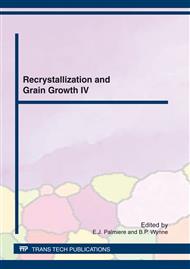p.751
p.758
p.764
p.770
p.776
p.782
p.788
p.794
p.800
Phase Field Model of Grain Growth Using Quaternions
Abstract:
The microstructure of a material determines its mechanical properties. Since microstructure can be tailored by thermo-mechanical processing of the metal, it is important to understand how the microstructure evolves under thermo-mechanical processing. We have constructed a phase field formalism to study recrystallization and grain growth in polycrystalline material. A unique feature of our model is that the Euler Angles (φ1,φ,φ2), obtained from Electron Back Scattered Diffraction (EBSD) data of a polycrystalline sample can be taken as an input to our model. In our model, the grain orientations at discrete grid points are represented by a non-conserved vector field, namely a quaternion. The free energy used for the evolution of the local orientations contains bulk energy for various preferred grain types and grain boundary energy. The grain orientations evolve in time following a Langevin dynamics. So far we have established that the rate of grain growth follows the usual L ~ t1/2 scaling law when the grain boundary energy is independent of the misorientation angle between neighboring grains. Work on other aspects of this model is in progress.
Info:
Periodical:
Pages:
776-781
Citation:
Online since:
April 2012
Authors:
Keywords:
Price:
Сopyright:
© 2012 Trans Tech Publications Ltd. All Rights Reserved
Share:
Citation:


